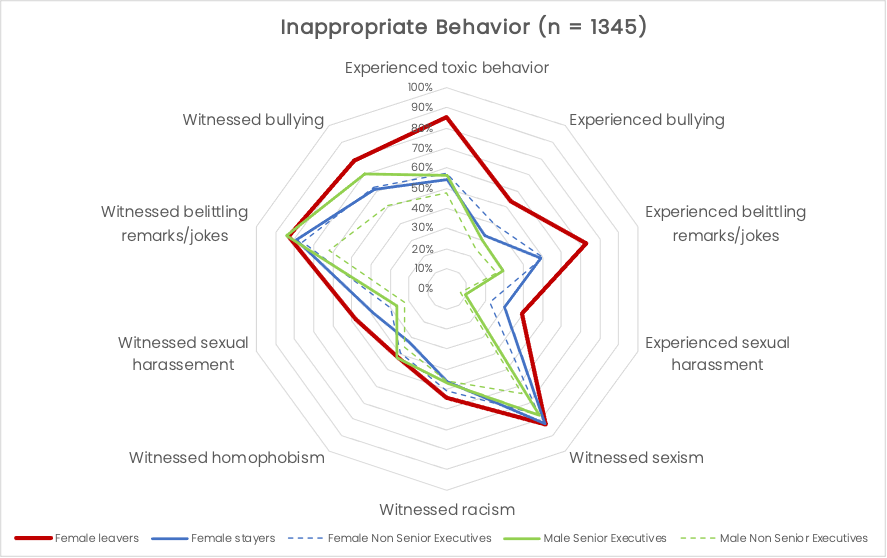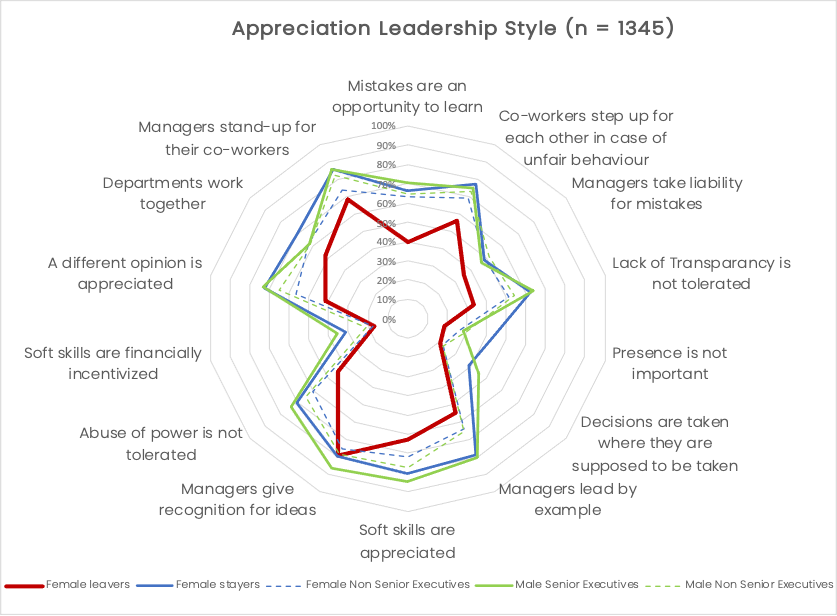Een nieuw ‘probleem zonder naam’ in de Belgische financiële sector
The problem that lay buried, unspoken, for many years in the minds of American women. It was a strange stirring, a sense of dissatisfaction, a yearning that women suffered in the middle of the twentieth century in the United States. Each suburban wife struggled with it alone. As she made the beds, shopped for groceries, matched slipcover material, ate peanut butter sandwiches with her children, chauffeured Cub Scouts and Brownies, lay beside her husband at night- -she was afraid to ask even of herself the silent question – “Is this all?”
Betty Friedan, The Feminine Mystique, 1963, p. 5
A new problem that has no name?.- In 1963 benoemde Betty Friedan het onbehagen dat leefde bij witte hoger opgeleide huisvrouwen uit de Amerikaanse middenklasse ‘a problem that has no name’. Precies 60 jaar later, vraagt Nathalie Delaere zich af of er een nieuw "problem that has no name" bestaat bij vrouwelijke senior managers. Vrouwen hebben de voorbije 60 jaar vlot toegang gekregen tot universiteiten, hebben hun plaats veroverd op de arbeidsmarkt en stoten stilaan door tot de top van het bedrijfsleven. Maar zijn ze bang om de vraag te stellen: "Is dit alles?"
Delaere was één van hen, stelde de vraag, zegde haar baan op na een carrière van meer dan 26 jaar en onderzocht de vraag hierbij aangemoedigd door gelijkgestemde vrouwen die allen een soort van onbehagen ervaarden als vrouwen aan de top. Zou hun ervaring kunnen wijzen op een meer algemeen onderliggende malaise, vergelijkbaar met Betty Friedans "a problem that has no name"? in de jaren ’50-’60.
Ze onderzocht de sector die ze zelf het best kent, namelijk de Belgische financiële sector. Deze sector heeft iets meer vrouwen dan mannen in dienst. Ondanks dit feit is de vertegenwoordiging van vrouwen op het niveau van het senior management en directiecomité nog steeds relatief laag. In 2022 werd voor het eerst de drempel van 30% vrouwen op senior managementniveau bereikt. Op het niveau van het directiecomité is hun aantal beperkt tot 23%. De mannelijk (over)vertegenwoordig bedraagt met andere woorden respectievelijk 70% en 77%.
Delaere onderzocht de vraag in drie stappen: (i) een bevraging van 1351 mensen over de ervaren carrièrebelemmeringen, (ii) diepte-interviews met 10 vrouwen uit directiecomités en (iii) het voorleggen van de bevindingen aan 15 CEO's van financiële instellingen.
Bijna 4 vrouwelijke senior managers op 10 overwegen om hun job op te zeggen, en nee, niet omwille van work-life balance. Delaere legde bloot dat meer dan een derde van de in de enquête bevraagde vrouwelijke senior managers overwegen hun baan op te zeggen omwille van de bedrijfscultuur, leiderschapsstijl en kantoorpolitiek. De helft van de geïnterviewde vrouwen uit directiecomités gaven aan dat bij een vorige werkgever daadwerkelijk te hebben gedaan.
Meer dan 3 vrouwelijke senior managers op 10 hebben minstens 1 keer in hun carrière seksueel grensoverschrijdende gedrag ervaren. Bij vrouwen die overwegen te vertrekken, betreft het vier vrouwen op tien. Naast seksueel grensoverschrijdend gedrag ervaren deze vrouwen ook vaak kleinerende opmerkingen, ongepaste grappen en giftig gedrag. Opmerkelijk is dat ook de bevraagde mannen bevestigen deze laatste vormen van ongepast gedrag te hebben waargenomen.

Vrouwelijke senior managers minder positief over de ervaren leiderschapsstijl. - Het is geen verrassing dat vrouwelijke senior executives die overwegen te vertrekken, de dominante leiderschapsstijl, zoals in de grafiek hieronder geïllustreerd, significant minder positief ervaren in vergelijking met de andere senior managers. Ze lijden voornamelijk onder machtsmisbruik en hebben het gevoel dat hun mening niet wordt gewaardeerd wanneer ze die uiten. Ook geloven ze dat er geen ruimte is voor 'fouten'. Een meerderheid van deze vrouwen geven aan dat ze regelmatig assimileren, hun gedrag afstemmen op het gedrag van de dominante groep. Door dit te doen kunnen ze vervreemd geraken van zichzelf en laten ze na om hun eigen perspectief naar voor te brengen. Dit is jammer want het voordeel van diversiteit gaat op die manier verloren.

Iedereen worstelt met kantoor politiek, niet alleen vrouwen. Alle senior managers die deelnamen aan de enquête en de interviews doen dat. Ze linken kantoorpolitiek aan macht en een gebrek aan transparantie. Zowel de enquête als de interviews lieten zien dat hoe hoger men in de hiërarchie komt, des te meer kantoorpolitiek er speelt. De metafoor van een schaakspel werd meer dan eens gebruikt. De pionnen bewegen, maar niemand lijkt precies te weten waarom en hoe, behalve de schaakspelers zelf.
Diversiteit met of zonder Inclusie. De interviews lieten zien dat er twee zeer verschillende opvattingen zijn over hoe gendergelijkheid kan worden vergroot. In de eerste opvatting ligt de nadruk op het coachen en begeleiden van vrouwen zodat ze zich gemakkelijker kunnen bewegen in het bestaande systeem. Het doel is kwantitatieve diversiteit. Voorstanders van deze opvatting zijn de geïnterviewden die het grootste deel van hun carrière in dezelfde organisatie hebben doorgebracht en in een token-positie zitten in het directiecomité.
In een alternatieve opvatting, moet de huidige bedrijfscultuur meer inclusief worden door stereotiep mannelijke en vrouwelijke kenmerken meer met elkaar in evenwicht te brengen. De norm die historisch prevaleerde is, in deze visie, niet langer houdbaar. In deze opvatting is 'cultuur aanpassen' belangrijker dan 'enkel het aantal vrouwen verhogen' of van vrouwen te verwachten ‘dat ze zich gaan gedragen als mannen’.
CEO’s steken de handen uit de mouwen. Bovenstaande bevindingen zijn hard aangekomen bij de 15 CEO’s. Samen met Wo-Men in Finance, zijn ze vast besloten om hier verder mee aan de slag te gaan. Door de moed te hebben gehad om deel te nemen aan het onderzoek en hier transparant over te willen communiceren, heeft de sector het belangrijke signaal gegeven dat diversiteit en inclusie een prioriteit is.
Uit het onderzoek van Delaere blijkt dat indien er niet snel werk wordt gemaakt van een meer inclusieve bedrijfscultuur, het risico bestaat dat de sector moeite zal hebben om vrouwelijke senior managers aan te trekken en aan boord te houden. Een nieuw ‘problem that has no name’ dreigt.

Nathalie Delaere
Mobile: +32 477 510 100
www.linkedin.com/in/nathalie-delaere
https://www.nathaliedelaere.com/
Bibliografie
Acker, J. (1990). Hierarchies, Jobs, Bodies: A Theory of Gendered Organizations. Gender & Society, 4(2), 139–158. https://doi.org/10.1177/089124390004002002
Acker, J. (2004). Gender, Capitalism and Globalization. Critical Sociology, 30(1), 17–41. https://doi.org/10.1163/156916304322981668
Acker, J. (2006a). The gender regime of Swedish banks. Scandinavian Journal of Management, 22(3), 195–209. https://doi.org/10.1016/j.scaman.2006.10.004
Acker, J. (2006b). Comments on: “The gender regime of Swedish banks.” Scandinavian Journal of Management, 22(3), 210–212. https://doi.org/10.1016/j.scaman.2006.08.004
Alvesson, M., & Billing, Y. (2009). Understanding Gender and Organizations. SAGE Publications Ltd. https://doi.org/10.4135/9781446280133
Bem, S. L. (1974). The measurement of psychological androgyny. Journal of Consulting and Clinical Psychology, 42(2), 155–162. https://doi.org/10.1037/h0036215
Bem, S. L. (1981). Gender schema theory: A cognitive account of sex typing. Psychological Review, 88(4), 354–364. https://doi-org.kuleuven.e-bronnen.be/10.1037/0033-295X.88.4.354
Big Think (Director). (2012, April 24). Carol Gilligan on Women and Moral Development | Big Think. https://www.youtube.com/watch?v=2W_9MozRoKE
Braun, V., & Clarke, V. (2006). Using thematic analysis in psychology. Qualitative Research in Psychology, 3(2), 77–101. https://doi.org/10.1191/1478088706qp063oa
Broadbridge, A., & Simpson, R. (2011). 25 Years On: Reflecting on the Past and Looking to the Future in Gender and Management Research. British Journal of Management, 22(3), 470–483. https://doi.org/10.1111/j.1467-8551.2011.00758.x
Bryman, A. (2004). Qualitative research on leadership: A critical but appreciative review. The Leadership Quarterly, 15(6), 729–769. https://doi.org/10.1016/j.leaqua.2004.09.007
Cabrera, S. F., Sauer, S. J., & Thomas-Hunt, M. C. (2009). The Evolving Manager Stereotype: The Effects of Industry Gender Typing on Performance Expectations for Leaders and Their Teams. Psychology of Women Quarterly, 33(4), 419–428. https://doi.org/10.1111/j.1471-6402.2009.01519.x
Calas, M. B., & Smircich, L. (2006). From the ‘Woman’s Point of View’ Ten Years Later: Towards a Feminist Organization Studies. In S. Clegg, C. Hardy, T. Lawrence, & W. Nord, The SAGE Handbook of Organization Studies (pp. 284–346). SAGE Publications Ltd. https://doi.org/10.4135/9781848608030.n9
Cardador, M. T., Hill, P. L., & Salles, A. (2022). Unpacking the Status-Leveling Burden for Women in Male-Dominated Occupations. Administrative Science Quarterly, 67(1), 237–284. https://doi.org/10.1177/00018392211038505
Chatman, J. A., & O’Reilly, C. A. (2016). Paradigm lost: Reinvigorating the study of organizational culture. Research in Organizational Behavior, 36, 199–224. https://doi.org/10.1016/j.riob.2016.11.004
Cheryan, S., & Markus, H. R. (2020). Masculine defaults: Identifying and mitigating hidden cultural biases. Psychological Review, 127(6), 1022–1052. https://doi.org/10.1037/rev0000209
Connell, R. W. (1998). Masculinities and Globalization. Men and Masculinities, 1(1), 3–23. https://doi.org/10.1177/1097184X98001001001
Dogaru-Tulică, A.-L. (2019). Women Leadership: Characteristics and Perceptions. Challenges of the Knowledge Society, 1182–1189.
Donnelly, K., & Twenge, J. M. (2017). Masculine and Feminine Traits on the Bem Sex-Role Inventory, 1993–2012: A Cross-Temporal Meta-Analysis. Sex Roles, 76(9), 556–565. https://doi.org/10.1007/s11199-016-0625-y
Draulans, V. (2012). Vrouwenwerk: Voor meer V/M-diversiteit op het werk. Lannoocampus; Leuven. https://lirias.kuleuven.be/retrieve/638950
Eagly, A. H. (1997). Sex differences in social behavior: Comparing social role theory and evolutionary psychology. American Psychologist, 52(12), 1380–1383. https://doi.org/10.1037/0003-066X.52.12.1380.b
Eagly, A. H. (2007). Female Leadership Advantage and Disadvantage: Resolving the Contradictions. Psychology of Women Quarterly, 31(1), 1–12. https://doi.org/10.1111/j.1471-6402.2007.00326.x
Eagly, A. H., & Johnson, B. T. (1990). Gender and leadership style: A meta-analysis. Psychological Bulletin, 108(2), 233–256. https://doi.org/10.1037/0033-2909.108.2.233
Eagly, A. H., & Karau, S. J. (2002). Role congruity theory of prejudice toward female leaders. Psychological Review, 109(3), 573–598. https://doi-org.kuleuven.e-bronnen.be/10.1037/0033-295X.109.3.573
Eagly, A. H., Karau, S. J., & Makhijani, M. G. (1995). Gender and the effectiveness of leaders: A meta-analysis. Psychological Bulletin, 117(1), 125–145. https://doi.org/10.1037/0033-2909.117.1.125
Elley-Brown, M. J., & Pringle, J. K. (2021). Sorge, Heideggerian Ethic of Care: Creating More Caring Organizations. Journal of Business Ethics: JBE, 168(1), 23–35. https://doi.org/10.1007/s10551-019-04243-3
Friedman, S. D., & Greenhaus, J. H. (2000). Work and Family—Allies or Enemies? Oxford University Press. https://doi.org/10.1093/acprof:oso/9780195112757.001.0001
Frkal, R. A., & Criscione-Naylor, N. (2020). Opt-out stories: Women’s decisions to leave corporate leadership. Gender in Management: An International Journal, 36(1), 1–17. https://doi.org/10.1108/GM-09-2019-0154
Gilligan, C. (1982). In a different voice: Psychological theory and women’s development. Harvard university press.
Gilligan, C. (1995). Moral Orientation and Moral Development [1987]. In Justice And Care. Routledge.
Gilligan, C., & Attanucci, J. (1988). Two Moral Orientations: Gender Differences and Similarities. Merrill-Palmer Quarterly, 34(3), 223–237.
Greene, J. C., Caracelli, V. J., & Graham, W. F. (1989). Toward a Conceptual Framework for Mixed-Method Evaluation Designs. Educational Evaluation and Policy Analysis, 11(3), 255–274. https://doi.org/10.3102/01623737011003255
Harrison, R. L., Reilly, T. M., & Creswell, J. W. (2020). Methodological Rigor in Mixed Methods: An Application in Management Studies. Journal of Mixed Methods Research. https://doi.org/10.1177/1558689819900585
Held, V. (2014). The Ethics of Care as Normative Guidance: Comment on Gilligan. Journal of Social Philosophy, 45(1), 107–115. https://doi.org/10.1111/josp.12051
Hofstede, G. (1998). Attitudes, Values and Organizational Culture: Disentangling the Concepts. Organization Studies, 19(3), 477–493. https://doi.org/10.1177/017084069801900305
Hsu, N., Badura, K. L., Newman, D. A., Speach, M. E. P. (2021). Gender, “masculinity,” and “femininity”: A meta-analytic review of gender differences in agency and communion. Psychological Bulletin, 147(10), 987–1011. https://doi.org/10.1037/bul0000343
Jackson, T. (2020). The legacy of Geert Hofstede. International Journal of Cross Cultural Management, 20(1), 3–6. https://doi.org/10.1177/1470595820915088
Jarrett, M. (2017, April 24). The 4 Types of Organizational Politics. Harvard Business Review. https://hbr.org/2017/04/the-4-types-of-organizational-politics
Johnson, R. B., Onwuegbuzie, A. J., & Turner, L. A. (2007). Toward a Definition of Mixed Methods Research. Journal of Mixed Methods Research, 1(2), 112–133. https://doi.org/10.1177/1558689806298224
Kandola, B. (2012). Qualitative Organizational Research: Core Methods and Current Challenges. In Qualitative Organizational Research: Core Methods and Current Challenges (pp. 258–274). SAGE Publications, Inc. https://doi.org/10.4135/9781526435620
Kanter, R. M. (1977). Men and women of the corporation (2nd ed.). Basic Books.
Keener, E., & Mehta, C. (2017). Sandra Bem: Revolutionary and Generative Feminist Psychologist. Sex Roles, 76(9–10), 525–528. https://doi.org/10.1007/s11199-017-0770-y
Kelan, E. K., & Wratil, P. (2021). CEOs as agents of change and continuity. Equality, Diversity and Inclusion: An International Journal, 40(5), 493–509. https://doi.org/10.1108/EDI-06-2020-0171
King, E. B., Hebl, M. R., George, J. M., & Matusik, S. F. (2010). Understanding Tokenism: Antecedents and Consequences of a Psychological Climate of Gender Inequity. Journal of Management, 36(2), 482–510. https://doi.org/10.1177/0149206308328508
Koenig, A. M., Eagly, A. H., Mitchell, A. A., & Ristikari, T. (2011). Are leader stereotypes masculine? A meta-analysis of three research paradigms. Psychological Bulletin, 137(4), 616–642. https://doi.org/10.1037/a0023557
Lawrence, T. B., & Maitlis, S. (2012). Care and Possibility: Enacting an Ethic of Care Through Narrative Practice. The Academy of Management Review, 37(4), 641–663.
LeanIn.Org & McKinsey & Company. (2022). Women in the workplace 2022. https://www.mckinsey.com/featured-insights/diversity-and-inclusion/wome…
Loden, M. (1987). Recognizing Women’s Potential: No Longer Business as Usual. Management Review, 76(12), 44.
Maguire, M., & Delahunt, B. (2017). Doing a thematic analysis: A practical, step-by-step guide for learning and teaching scholars. All Ireland Journal of Higher Education, 9(3), Article 3. https://ojs.aishe.org/index.php/aishe-j/article/view/335
Martin, W., & Shaw, B. (1993). White, Gilligan, and the Voices of Business Ethics. Business Ethics Quarterly, 3(4), 437–443. https://doi.org/10.2307/3857288
Merens, A. (2022). Een lange weg. De ondervertegenwoordiging van vrouwen in management en top kader nader verklaard. Sociaal en Cultureel Planbureau.
Metz, I. (2011). Women leave work because of family responsibilities: Fact or fiction?*. Asia Pacific Journal of Human Resources, 49(3), 285–307. https://doi.org/10.1177/1038411111413216
Moe, K. S., & Shandy, D. J. (2010). Glass Ceilings and 100-Hour Couples: What the Opt-Out Phenomenon Can Teach Us about Work and Family. University of Georgia Press.
Nielsen T. C. & Kepinski L. (2020). Inclusion Nudges for Leaders. Inclusion Nudges.
Onderzoeksrapport “Vrouwen aan het woord.” (n.d.). Carla Clarissa. Retrieved November 3, 2022, from https://carlaclarissa.com/onderzoeksrapport-vrouwen-aan-het-woord-2/
Roos, H., & Zanoni, P. (2016). : Gender equality in a high-tech Belgian company. In Overcoming Challenges to Gender Equality in the Workplace. Routledge.
Rosener, J. B. (1990). Ways Women Lead. Harvard Business Review, 68(6), 119–125.
Rynes, S. L., Bartunek, J. M., Dutton, J. E., & Margolis, J. D. (2012). Introduction to Special Topic Forum: Care and Compassion Through an Organizational Lens: Opening up New Possibilities. The Academy of Management Review, 37(4), 503–523.
Salles, A., & Choo, E. K. (2020). Queen Bee phenomenon: A consequence of the hive. The Lancet, 395(10228), 940. https://doi.org/10.1016/S0140-6736(20)30597-3
Savage, M., & Wajcman, J. (1999) Managing Like a Man: Women and Men in Corporate Management, Cambridge: Polity Press.
Schein, E. H. (1986). Organizational culture and leadership (4th print.). Jossey-Bass.
Schein, V. E., Mueller, R., Lituchy, T., & Jiang Liu. (1996). Think manager -- think male: A global phenomenon? Journal of Organizational Behavior, 17(1), 33–41. https://doi.org/10.1002/(SICI)1099-1379(199601)17:1<33::AID-JOB778>3.0…
Schneider, B. (1987). The People Make the Place. Personnel Psychology, 40(3), 437–453. https://doi.org/10.1111/j.1744-6570.1987.tb00609.x
Schneider, B., Goldstein, H. W., & Smith, D. B. (1995). The Asa Framework: An Update. Personnel Psychology, 48(4), 747–773. https://doi.org/10.1111/j.1744-6570.1995.tb01780.x
Simpson, R., & Lewis, P. (2005). An investigation of silence and a scrutiny of transparency: Re-examining gender in organization literature through the concepts of voice and visibility. Human Relations, 58(10), 1253–1275. https://doi.org/10.1177/0018726705058940
Spangler, E., Gordon, M. A., & Pipkin, R. M. (1978). Token Women: An Empirical Test of Kanter’s Hypothesis. American Journal of Sociology, 84(1), 160–170. https://doi.org/10.1086/226745
Spangsdorf, S., & Forsythe, A. (2021). The glass slipper effect: Understanding the Nordic gender equality paradox from an identity fit perspective. Career Development International, 26(6), 766–785. https://doi.org/10.1108/CDI-01-2021-0010
Sull, D., Sull, C., Cipolli, W., & Brighenti, C. (2022). Why Every Leader Needs to Worry About Toxic Culture. MIT Sloan Management Review, 63(3), 1–8.
Sull, D., Sull, C., & Zweig, B. (2022). Toxic Culture Is Driving the Great Resignation. MIT Sloan Management Review, 63(2), 1–9.
Thompson, J. (2022). A Guide to Abductive Thematic Analysis. The Qualitative Report, 27(5), 1410–1421. https://doi.org/10.46743/2160-3715/2022.5340
Tomkins, L., & Simpson, P. (2015). Caring Leadership: A Heideggerian Perspective. Organization Studies, 36(8), 1013–1031. https://doi.org/10.1177/0170840615580008
Topić, M. (Ed.). (2022). Towards a New Understanding of Masculine Habitus and Women and Leadership in Public Relations. Routledge. https://doi.org/10.4324/9781003161622
Vinkenburg, C. J., van Engen, M. L., Eagly, A. H., & Johannesen-Schmidt, M. C. (2011). An exploration of stereotypical beliefs about leadership styles: Is transformational leadership a route to women’s promotion? The Leadership Quarterly, 22(1), 10–21. https://doi.org/10.1016/j.leaqua.2010.12.003
White, T. I. (1992). Business, Ethics, and Carol Gilligan’s “Two Voices.” Business Ethics Quarterly, 2(1), 51–61. https://doi.org/10.2307/3857223
Wille, B., Wiernik, B. M., Vergauwe, J., Vrijdags, A., & Trbovic, N. (2018). Personality characteristics of male and female executives: Distinct pathways to success? Journal of Vocational Behavior, 106, 220–235. https://doi.org/10.1016/j.jvb.2018.02.005
Wyatt, M., & Doldor, E. (2022, May 30). Office Politics Don’t Have to Be Toxic. Harvard Business Review. https://hbr.org/2022/05/office-politics-dont-have-to-be-toxic
Yoder, J. D. (1994). Looking Beyond Numbers: The Effects of Gender Status, Job Prestige, and Occupational Gender-Typing on Tokenism Processes. Social Psychology Quarterly, 57(2), 150–159. https://doi.org/10.2307/2786708









